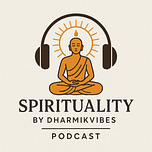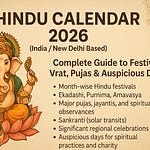India stands at the intersection of two powerful forces: an ancient spiritual heritage stretching back thousands of years and a booming, digitally connected generation with global influences. Amidst this, a quiet yet profound shift is underway - the transformation of spirituality itself, led by India’s Gen Z.
They are not rejecting faith - they are reinventing it. Reimagining it. Reclaiming it.
With smartphones in hand, headphones playing ancient chants remixed into lo-fi beats, and social media feeds full of modern mystics, India’s youngest adults are crafting a spirituality that is personal, intuitive, tech-infused, and emotional.
1. A Generation Raised with Questions, Not Just Answers
Born roughly between 1997 and 2012, Gen Z grew up in a world where information was never more than a few taps away. They witnessed rapid societal shifts - the rise of mental health conversations, startup culture, climate anxiety, economic pressure, and political polarization. Unlike previous generations that were often taught to accept tradition without question, Gen Z was encouraged to explore, critique, and seek individual meaning.
And so, when it comes to spirituality, this generation doesn’t ask “What must I follow?” - they ask “What resonates with me?”
They question rituals, explore different faiths, read simplified versions of religious texts, and listen to podcasts by both spiritual gurus and skeptical thinkers. For them, spirituality is not about identity - it's about experience.
2. From Inherited Religion to Chosen Spirituality
Data reveals an apparent paradox: even as global religious affiliation declines, young Indians are increasingly engaging with spiritual ideas. According to a 2023 YouGov-Mint Survey:
53% of Gen Z Indians believe religion is important
62% pray regularly, though often on their own terms
A growing number use apps, music, and social media for spiritual engagement
Contrast this with global trends: a Pew Research Center study from 2022 noted that religious affiliation worldwide fell by 1% from 2010 to 2020, with more people identifying as “spiritual but not religious.”
In India, however, the trend is nuanced. While traditional, institutional religion might be losing appeal, the spiritual impulse remains strong - only now, it’s user-defined, emotion-driven, and multimedia-enabled.
What does this shift look like?
Temples visited less out of obligation, more for peace
Festivals celebrated not out of compulsion, but as shared community experiences
Mantras used not just in prayer, but as healing affirmations or productivity tools
Rituals like fasting reinterpreted as mindfulness and detox
3. Spirituality as Mental Health Support
The pressures of modern life - unstable careers, academic stress, social isolation, identity struggles - have taken a toll on India’s youth. In the absence of strong emotional support systems, many have turned inward. Spirituality, in this context, becomes a form of coping.
Therapists across urban India report that their young clients often talk about journaling during full moons, drawing tarot cards, lighting incense, or meditating - not out of religiosity, but for clarity, grounding, or healing.
“I started going to a nearby ashram during my internship slump,” says a 23-year-old marketing student from Bengaluru. “I’m not religious, but sitting in silence and listening to bhajans helped me feel less lost.”
Why does spirituality appeal to Gen Z’s emotional needs?
It provides structure in an unstructured world
It offers hope in uncertain times
It cultivates a sense of agency - a belief that change begins from within
It connects them to something bigger than the self - without requiring blind faith
4. The Digital Temple: Instagram, YouTube & Reels
Gen Z’s native language is digital - and spirituality has found new life in that language.
A 2023 survey by OMTV, a spiritual storytelling platform, revealed that:
80% of Indians aged 18 to 30 consume spiritual content online
Most do so via short videos, motivational clips, podcasts, or story-based content
Over 50% follow spiritual influencers who use everyday language to explain complex ideas
On YouTube, videos titled “5 Lessons from Bhagavad Gita for Today’s Hustle Culture” or “How to Meditate When You Have Anxiety” garner hundreds of thousands of views.
On Instagram, creators share snippets of teachings from Ramana Maharshi, Kabir, or Guru Nanak in reels, sometimes overlayed with music or cinematic visuals. The format is bite-sized - 60 seconds of timeless wisdom, reinterpreted for a fast-paced, overstimulated world.
Rather than attending long discourses, many Gen Zers prefer:
Guided meditations on Spotify
Astrology readings via app
Live pujas streamed from temple accounts
Q&A sessions with relatable spiritual teachers on Instagram Live
5. A Surge in Experiential Spirituality & Solo Pilgrimages
Pilgrimage, once seen as the domain of the elderly or deeply devout, is being reinvented.
Places like Rishikesh, Kedarnath, Varanasi, Mount Abu, and Isha Foundation in Coimbatore are witnessing a surge in young travelers seeking “soulful breaks” rather than just vacations.
The Kedarnath pilgrimage in 2024 saw a record-breaking 35% increase in visitors under the age of 30, according to data from Uttarakhand Tourism. Many arrived alone - not in family groups - and shared their experience via vlogs or Instagram stories. For them, the trip wasn’t only religious - it was also introspective, therapeutic, and symbolic.
These “digital pilgrims” are bringing the sacred into the spotlight, but with a narrative that’s rooted in emotion and exploration rather than dogma.
“I walked barefoot to a hilltop temple in Maharashtra because I was going through heartbreak. I wasn’t seeking God - I was seeking silence,” wrote one Reddit user in r/India.
6. The Language of Healing and the Rise of New Rituals
Gen Z doesn’t just attend temples or read scriptures. They:
Charge crystals on full moons
Listen to chakra balancing tracks on YouTube
Light a diya during exam season
Use spiritual tattoos to signify protection
Create vision boards infused with ancient symbols like the Om or Trishul
They speak a new spiritual language:
"Grounding" replaces “sitting in silence”
"Manifestation" replaces “prarthana” (prayer)
"Energy cleansing" replaces “snan” (ritual bath)
"Vibrations" replace “aura” or “prana”
It’s not that the old meanings are lost - it’s that they’re being translated into a language of healing, emotional intelligence, and mindfulness.
7. Government’s Role and Cultural Influence
The Indian government, especially under the current leadership, has leaned into promoting spiritual heritage. Massive funding has been directed towards revamping sites like:
Kashi Vishwanath Corridor
Ram Janmbhoomi Mandir in Ayodhya
Mahakal Lok in Ujjain
Maha Kumbh Mela preparations
While the motives may be cultural, religious, or political depending on interpretation, the result is clear: faith infrastructure is being modernized, and young people are using it.
State tourism boards have also begun curating “spiritual circuits” aimed specifically at the youth - with better lodging, connectivity, café culture, and wellness experiences. What used to be pilgrimage is now “spiritual tourism.”
8. Criticism and Complexity: Is It All Real or Just Trendy?
Critics often point out that Gen Z’s spirituality can feel performative or superficial - especially when reduced to aesthetic Instagram photos of temples, yoga poses at sunrise, or astrology memes.
However, psychologists and sociologists urge a more nuanced view.
“Just because it’s online doesn’t mean it’s inauthentic,” says a Mumbai-based therapist. “Young people express community and emotion digitally. That doesn’t dilute the feeling - it just adapts it.”
Even if the engagement is brief, it can be transformative. A 10-minute guided meditation may not match a 3-hour aarti, but it can calm a mind in distress. A single mantra repeated before sleep might not be as elaborate as a havan, but it could anchor someone battling anxiety.
9. What Lies Ahead: Spirituality in the Age of AI and Algorithms
With the rise of AI, we are entering an era where personalized spiritual tools are becoming the norm. Imagine:
AI gurus answering questions about karma
Chatbots reciting daily Gita verses
Apps recommending spiritual practices based on your mood
Virtual temples with immersive experiences for global youth
Companies like Sattva, DivineAI, and even Spotify playlists curated with spiritual rhythms are shaping a new frontier - one where ancient wisdom meets algorithms.
For Gen Z, this is not contradictory. It’s intuitive.
10. Subcultures Within Gen Z: Spirituality Across Urban-Rural Lines
While most discourse on Gen Z’s spiritual evolution centers around urban, middle-class youth, there’s an equally significant shift happening in India’s tier-2 and tier-3 cities, small towns, and even rural belts. The form and expression may differ, but the underlying spirit of personalized connection to the divine remains strong.
In smaller towns:
Youth are participating in local melas, temple festivals, and traditional yatras - but they're vlogging them, sharing reels, and adding modern commentary.
WhatsApp groups for bhakti songs, religious quotes, or group meditation are common - often managed by younger family members.
Tech-savvy village youth are attending virtual discourses by teachers like Gaur Gopal Das, Sadhguru, or Shri Shivani - blending the vernacular with the digital.
Unlike their parents, who inherited faith passively, these young people reassert their beliefs through choice, technology, and self-expression.
Meanwhile, tribal communities and indigenous groups - from the Santhals to Nagas - are also seeing Gen Z youth balancing traditional spiritual practices with broader Hindu or pan-Indian ideas of dharma, especially in festivals and music.
11. Spiritual Entrepreneurship: Gen Z Building Businesses of Belief
Another emerging trend is the intersection of spirituality and entrepreneurship, driven largely by young founders.
From wellness startups rooted in Indian spiritual knowledge to astrology apps, temple tourism platforms, and artisanal products tied to rituals and symbolism - Gen Z is commercializing spirituality, but often with care and craft.
Some notable examples:
Daily Dharma decks: Indian spiritual card decks for daily inspiration, akin to tarot
Mindfulness journals based on chakras or astrological signs
Bhakti music remix collectives, blending classical ragas with lo-fi and EDM
Temple merchandise startups offering contemporary designs for religious symbols
Pilgrimage concierge services that curate seamless spiritual journeys for younger, working professionals
This is not exploitation - it’s integration. Gen Z is infusing the sacred into commerce in ways that make it more relatable, accessible, and desirable.
12. Gender, Identity, and Queer Spirituality
Perhaps one of the most important and under-discussed facets of Gen Z’s spiritual transformation in India is how queer and gender-diverse youth are reclaiming spiritual space.
Traditionally, many LGBTQIA+ individuals have felt alienated by rigid religious structures. But a wave of Gen Z individuals are embracing spirituality on their own terms, drawing from inclusive philosophies within Indian texts and mythologies.
Examples include:
Viewing Ardhanarishvara (the half-male, half-female form of Shiva-Parvati) as a metaphor for gender fluidity
Celebrating gods like Krishna, who broke gender norms, as symbols of fluid love and identity
Reinterpreting ancient stories through a queer lens, in art and poetry
Creating online safe spaces for inclusive devotion, where caste, gender, and orientation are no longer gatekeepers
As one young queer poet from Chennai said: “Spirituality, to me, is about coming home to myself. And Indian culture has always had room for the mystical, the in-between, the non-binary - even if society forgot it.”
13. India’s Gen Z in a Global Context
Globally, Gen Z is showing a spiritual hunger unseen since the 1960s counterculture movement. But while Western youth are rediscovering Eastern philosophies — mindfulness, meditation, stoicism, yoga - Indian Gen Z is experiencing something different.
They’re not discovering it. They’re inheriting it - and reimagining it.
This makes India unique. It is simultaneously:
A source of ancient wisdom
A consumer of global spiritual trends
A marketplace of modern faith-tech innovation
A country with deep-rooted sacred geography
A democracy where belief intersects with identity and politics
India’s youth - especially Gen Z - are at the crossroads of all these forces. They’re using global tools (apps, reels, memes), engaging with ancient Indian knowledge (Upanishads, Ayurveda, Tantra), and applying them to modern problems: burnout, identity crises, environmental grief, and loneliness.
14. Is This a Lasting Shift or a Trend Cycle?
Critics argue that Gen Z’s interest in spirituality may be fleeting - just another phase in the cycle of online aesthetics, like cottagecore, minimalism, or wellness culture. After all, what comes after sage-smudging and Gita reels? Back to nihilism?
But there’s reason to believe this shift is deeper and more structural.
Here’s why:
India is becoming younger and more anxious: With 65% of its population under 35, and with rising mental health needs, spiritual tools are not luxury - they’re survival mechanisms.
Tech is now a vehicle for faith: With AI, VR, voice assistants, and language localization, spiritual content will only become more immersive, intuitive, and available.
Cultural pride is growing: Across cinema, literature, fashion, and politics, there’s a surge in interest in India’s cultural heritage. Spirituality is often the soft power language that binds them all.
Institutions are adapting: Temples are setting up digital donation portals. Religious institutions are starting YouTube channels. Even schools and universities are incorporating meditation programs.
In short, Gen Z’s version of spirituality might look different - minimalist shrines, guided meditation instead of aarti, reels instead of rituals — but the roots run deep.
15. What It All Means for India’s Future
The choices of Gen Z today will shape the country's cultural trajectory for decades to come. Their reimagining of spirituality will affect:
Education: with renewed focus on ancient Indian knowledge systems
Tourism: with increased demand for spiritual destinations and heritage circuits
Technology: with more innovations in faith-tech, wellness AI, and ritual automation
Politics: with shifting ideas of identity, belonging, and soft nationalism
Mental Health: with integrated approaches combining psychology, philosophy, and meditation
Perhaps most importantly, it will affect how India speaks to itself - not just as a land of temples and rituals, but as a living, evolving spiritual civilization that can meet its youth where they are.
A Generation Finding Light on Its Own Path
India’s Gen Z is not abandoning spirituality. They’re democratizing it, digitizing it, and redesigning it to reflect their reality.
Their spirituality is:
Less about rituals, more about relevance
Less about rules, more about resonance
Less about obligation, more about observation
They may not chant at dawn or fast on Mondays, but they seek meaning through other ways - in solitude, sound, silence, and shared digital experiences.
And in doing so, they are not breaking from India’s spiritual roots - they are watering them anew, ensuring that the tree grows with fresh leaves for a modern world
A Generation with Headphones in Their Ears and a Prayer in Their Heart
India’s Gen Z is not seeking to replicate their grandparents’ rituals. Nor are they wholly discarding them.
They are:
Rethinking prayer as intention
Redefining divinity as presence
Replacing fear with curiosity
Reclaiming Indian wisdom without dogma
Whether in mountain retreats or midnight journaling sessions, in temple visits or tarot readings, they are asking: “Who am I?”, “What is truth?”, “What gives me peace?”
And perhaps that - the relentless pursuit of authenticity, purpose, and healing - is the most spiritual thing of all.











